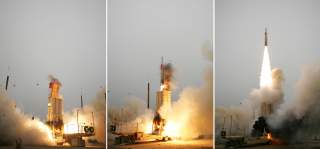Will Israel’s New Missile Defense System Stop Iran if a War Begins?
Or just a waste of money?
Israel’s new Arrow 3 anti-missile system has just passed a major milestone.
Not in Israel, but 6,000 miles away in Kodiak, Alaska. The Arrow 3 test on July 28 comes just days after Israel’s arch-enemy Iran itself tested a new ballistic missile.
“Flight Test Arrow-01 demonstrated the Israeli Arrow Weapon System’s ability to conduct a high altitude hit-to-kill engagement,” said the U.S. Missile Defense Agency announcement.
“Interceptor tests were conducted that successfully destroyed target missiles.”
“The Arrow-3 Interceptor successfully demonstrated an engagement capability against the exo-atmospheric target during the test. Although not part of the Israeli architecture, a U.S. AN-TPY2 radar participated in the test. Preliminary analysis indicates that test objectives were successfully achieved.”
“The performance was perfect,” announced Israeli Prime Minister Benjamin Netanyahu. “Every hit a bull’s eye.”
The Arrow 3 is a joint Israel-U.S. weapon designed to destroy ballistic missiles in outer space, before they have a chance to drop their warheads into the atmosphere. The project is managed by the U.S. Missile Defense Agency and the Israeli Missile Defense Organization, with development by Israel Aerospace Industries and Boeing.
The Arrow 3, an improved version of the earlier Arrow 2, is a two-stage hypersonic interceptor with an estimated range of 1,500 miles downrange and 62 miles high. It is armed with a kinetic warhead that destroys missiles through sheer high-speed impact.
Arrow 3 is part of a four-tier Israeli missile defense system: Iron Dome (which has seen extensive service against Hamas rockets fired from Gaza) against short-range rockets, the medium-range David’s Sling (equivalent to the U.S. Patriot system), the Arrow-2 against intermediate-range ballistic missiles, and the Arrow-3 against ICBMs. Though funded by the U.S. to the tune of nearly a billion dollars, the Arrow 3 is not part of American missile defense. The U.S. relies on the Ground-Based Missile Defense (GBMD) system for mid-course intercepts of missiles as they coast through space before releasing their warheads.
Interestingly, the Arrow 3 missile was tested in conjunction with the U.S. AN-TPY2 radar, a long-radar missile detection system that is the eyes of THAAD. Given that the U.S. has already deployed a Terminal High-Altitude Area Defense (THAAD) system to Israel, it raises the question of whether the Alaska test was designed to test the integration of Arrow 3 and THAAD.
Which brings us to Iran, which may or may not be developing nuclear weapons, but is developing missiles that can hit Israel, Europe (and in the worst nightmares of U.S. planners, America). On July 24, Iran tested a Shahab-3, a medium-range ballistic missile that 1,000 kilometers (621 miles) during the test. While not violating international law, the Shahab-3 does fly in the face of UN urgings that Tehran refrain from developing missiles that could potentially carry nuclear weapons.
Unfortunately, the Arrow 3 may not solve Israel’s problem. Israel missile defense against primitive Hamas rockets, or U.S. high-altitude missile defense tests, have a mixed record at best. Assuming that Arrow 3 works, and that it works against a salvo of Iranian missiles with warheads and decoys, this may not be the biggest threat Israel faces. Hezbollah’s estimated 130,000 rockets, some equipped with GPS guidance, may be a bigger threat.
Michael Peck is a contributing writer for the National Interest. He can be found on Twitter and Facebook.
Image: Wikimedia Commons.

